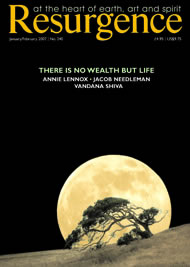THE SECRET LIFE OF TREES is not so much secret as discreet, a matter, as the subtitle puts it, of ‘How They Live and Why They Matter’. It is many books in one – a botanical primer, a register of the great families of trees, above all a tribute to the framework of all terrestrial life, a scientific vindication of the myth of the World Tree, Yggdrasil, “whose branches spread over the whole world”.
Even as individuals trees are extraordinary. Colin Tudge brilliantly depicts their lives as an orchestration of the Four Elements, a conjuring of air, water, earth and the sun’s fire into solid tissue by the alchemy of photosynthesis. The result, wood, is such a remarkable substance that the Chinese call it the Fifth Element. In the most majestic trees on Earth, the giant coastal redwoods of California, it is shape-
shifting, intelligent, making land while anchoring the tree. When the redwood’s roots are drowned they send up new roots vertically, which then sprout new lateral roots just below the level of the newly deposited silt, stabilising both tree and land. After several floods – stretching across maybe a thousand years – they end up “with a multi-layered root system like an inverted pagoda”.
But it’s the commonwealth of trees, their intricate relations with each other and a multitude of other organisms, that Tudge so powerfully evokes. The transactions of the forest infrastructure make images of nature ‘red in tooth and claw’ appear positively banal. Below the soil, tree-land is a huge co-operative. The fungal root-partners that are essential in helping trees extract minerals from the soil are shared between them, so that areas of forest may be physically joined up – one organism, a literal Yggdrasil. The same is virtually true – thanks to what Tudge calls “vaporous chemistry” – up in the canopy. Immeasurably complex systems of chemicals attract pollinators, navigate growing leaves towards the sun, control the temperature inside flowers, and signal to other trees to raise their levels of deterrent substances when predatory insects are busy. Tree communities become progressively more complex and interdependent, as each new coloniser – lichen, insect, bird – creates a new niche, and a new home for something else.
And we are inextricably part of it all. Humans are outgrowths of trees. The dextrous hands that nurtured our brains and our technologies evolved because of work-outs in the canopy. And though civilisation developed to some extent at the expense of trees, it could not have survived without them, as the major raw material for most of its history. Yet, just at the point when trees are more crucial than they have ever been, as regulators of the climate and ultimately the only renewable source of raw materials on the planet, we are continuing to trash them. Tudge argues that “the future endeavours of humanity must be geared to biological realities.” We will have to become parasites on trees again. Or, better still, symbiotic partners.
There is much in this scientifically meticulous book that has the feel and shape of myth. Perhaps this is no surprise, as the chemical communications of the forest world, with their immense information and ceaseless negotiation and innovation, are similar to human language, just as the outpouring of emotion about territory and season in birdsong is closer to music. The best nature writing embraces both modes. What could be a more powerful myth, more laden with moving lessons about mutual adaptation and living within limits, than the true story of the elephants and the mopane tree? Mopanes send out warning signals to their clan when they’re ravaged. So the elephants only eat a few leaves from each tree. They move upwind to new trees. The mopanes up the ante… “We cannot hear the trees calling to each other,” Tudge comments, “but the air is abuzz with their conversations.”
Reprinted from The Times.
Richard Mabey’s most recent book is Nature Cure.






